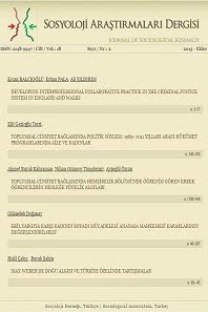THE ROLE OF NARRATIVE METHODS IN SOCIOLOGY: STORIES AS A POWERFUL TOOL TO UNDERSTAND INDIVIDUAL AND SOCIETY
-
THE ROLE OF NARRATIVE METHODS IN SOCIOLOGY: STORIES AS A POWERFUL TOOL TO UNDERSTAND INDIVIDUAL AND SOCIETY
Narrative, Storytelling Sociology,
___
- Altheide, D. L., Snow, R.P. (1991). Media Worlds in the Postjournalism Era. New York: Aldine de Gruyter.
- Andrews, M. et al. (2009). The Uses of Narrative: Explorations in Sociology, Psychology, and Cultural Studies. New Jersey: Transaction Publ.
- Barthes, R. (1977). Elements of Semiology. Farrar, Straus and Giroux: Paris.
- Bauman, Z. (2000). Liquid modernity. London: Polity Press.
- Erol-Işık, N. (2013). Parables as Indicators of Popular Wisdom: The Making of Piety Culture in Turkish Television Dramas. European Journal of Cultural Studies. 16(5): 565– 581.
- Ewick, P., Silbey, S. (1995). Subversive Stories and Hegemonic Tales: Toward a Sociology of Narrative. Law and Society Review, Vol 29(2): 197-210.
- Frank, A.W. (2002). Why Study People’s Stories? The Dialogical Ethics of Narrative Analysis. International Journal of Qualitative Methods. 1(1): 27-46.
- Franzosi, R. (1998). Narrative Analysis or Why (and How) Sociologists Should be Interested in Narrative. American Review of Sociology. 24: 517-54.
- Game, A., Metcalfe, A. (1996). Passionate Sociology, London: Sage.
- Hjvard, S. (2008). The Mediatization of Religion: A Theory of the Media as Agents of Religious Change. In Northern Lights: Media Studies Yearbook, 6(1):9-26.
- Maines, A. (1993). Narrative’s Moment and Sociology’s Phenomena: Toward a Narrative Sociology. The Sociological Quarterly, 34(1): 17-38.
- Merrigan, G., Huston C. L. (2004).Communication Research Methods. Wadsworth Pub Co.
- Öncü, A. (2006). Becoming secular muslims: Yaşar Nuri Öztürk as a super-subject on Turkish television. Meyers, Birgit and Moors, Annelies (Ed.), Religion, Media and the Public Sphere içinde (s. 227-240), Indiana, Indiana University Press.
- Poletta, F. et al (2011). The Sociology of Storytelling. Annual Review of Sociology, 37: 109-130.
- Schulz, W. (2004). Reconstructing Mediatization as an Analytical Concept. European Journal of Communication, 19: 87-100.
- ISSN: 2148-9947
- Yayın Aralığı: 2
- Başlangıç: 2010
- Yayıncı: Sosyoloji Derneği
DRAMATURJİK TEORİ EKSENİNDE SPOR
DİSTOPİK ROMANLARDA TOPLUMSAL KURGU
POLICE ACCOUNTABILITY SYSTEM IN ENGLAND AND WALES
İNGİLTERE VE GALLER’DE POLİS HESAP VEREBİLİRLİK SİSTEMİ
DIŞARIDA YEMEK: ESKİŞEHİR'DE YENİ ORTA SINIFIN FAST-FOOD YEME-İÇME ÖRÜNTÜLERİ
TOPLUMSAL CİNSİYET PERSPEKTİFİNDE SAĞLIK VE TIBBİLEŞTİRME
ÖZEL ALAN / KAMUSAL ALAN DİKOTOMİSİ: KADINLIĞIN "DOĞASI" VE KAMUSAL ALANDAN DIŞLANMIŞLIĞI
DIŞARIDA YEMEK: ESKİŞEHİR’DE YENİ ORTA SINIFIN FAST-FOOD YEME-İÇME ÖRÜNTÜLERİ
DIŞARIDA YEMEK: ESKİŞEHİR'DE YENİ ORTA SINIFIN FAST-FOOD YEME-İÇME ÖRÜNTÜLERİ
